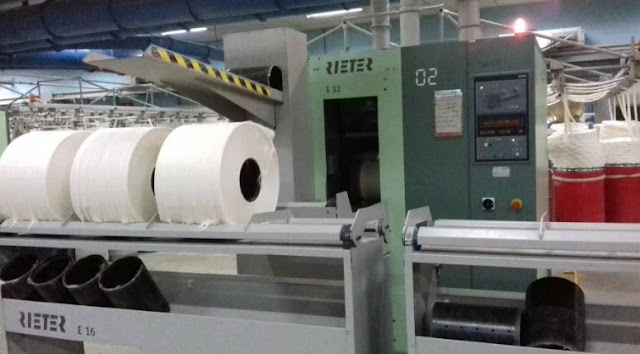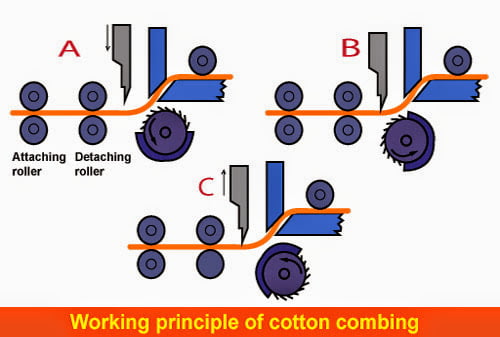Combing Faults with Causes and Remedies
Last updated on August 8th, 2023 at 12:13 am
Different Types of Combing Faults and Their Possible Remedies
Cutting Across
This fault indicates the thick and thin bars which occur from the one side of web to the other. The possible causes are –
- Incorrect roller setting, excessive draft, roller slippage or loose drafting rollers at the sliver and ribbon lap formers; lap former and comber drafting rollers.
- Incorrect timing of the detaching roller cam.
- Too deeply setting of the top comb.
- Top comb touching the back detaching roller.
- Lack of lubrication of top detaching roller.
- Stretching of the web in the condensing plate.
 |
Detaching Roller Lapping
The probable causes are –
- Oil on roller.
- Higher relative humidity percentage.
- Improper weighting of the top roller.
- Sticky dirt on roller.
Curling
The following are the probable causes –
- Incorrect timing of the detaching cam.
- Faulty top detaching roller covering.
- Dirt in the flutes of steel detaching roller.
- Air current originating in the aspirator, excessive brush speed or too low fan speed
- Incorrect atmospheric conditions; air may be too dry or too humid.
Longer fibres in the Waste
The possible causes are as follows –
- Defective back covered detaching roller.
- Foreign matters wedged between the nipper jaws.
- Faulty nipper setting.
- Presence of tailing hook in the fibres is a major cause.
- If the already detached fringe is fed back into the last raw of cylinder needles during backing off.
- If the detachment setting is wider than the required length of fibres.
Waste Flocking on Comber Needles
The causes are –
- Damaged brush.
- Hooked comber needles.
- Brush set too far from cylinder.
Lap Running Stack on Wooden Lap Rollers
- The pawl operates on too many teeth in the ratchet wheel on the wooden roller.
- The feed roller ratchet pawl operates on less no. of teeth.
Cotton not Combing through at One Head
The causes are –
- Improper gearing of the pawl with the feed roller ratchet.
- Incorrect nipper setting or foreign matters wedged between the nipper jaws.
- Back covered detaching roller requiring lubrication.
Damage of the Combing Needles
The probable causes are –
- Incorrect setting of comb with the adjacent parts i.e. too close to catch.
- The making of a thick overlay when a new lap is being put in for combing.
Short Fibres in all Slivers
The probable causes are –
- Poorly oriented fibres and hooked fibres which cause running of short fibres with the longer fibres and fibres breakage.
- Damaged needles.
Irregular Draw Box Sliver
The causes are –
- Unequal weighting of top drafting roller.
- Incorrect distribution of draft in the drafting zone.
- Unequal setting of detaching roller, rocking mechanism.
- Neps in the sliver.
- Tension draft.
- Grooved or worn roller covering.
Combing Faults Remedies
The remedies to the causes of various faults in combing are opposite. Steps i.e. if the fault is due to the incorrect setting; the setting should be corrected, if for improper lubrication, it needs correct lubrication and if for damage needles, they should be replaced and so on.




Greetings from Florida! I’m bored at work, so I decided to browse your site on my iPhone during lunch break. I love the information you provide here and can’t wait to take a look when I get home. I’m surprised at how fast your blog loaded on my cell phone .. I’m not even using WIFI, just 3G. Anyways, awesome blog!